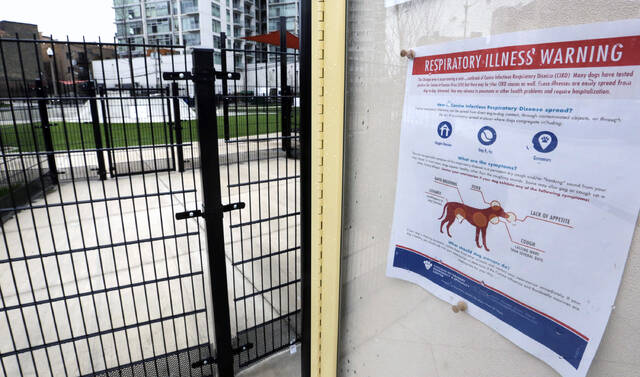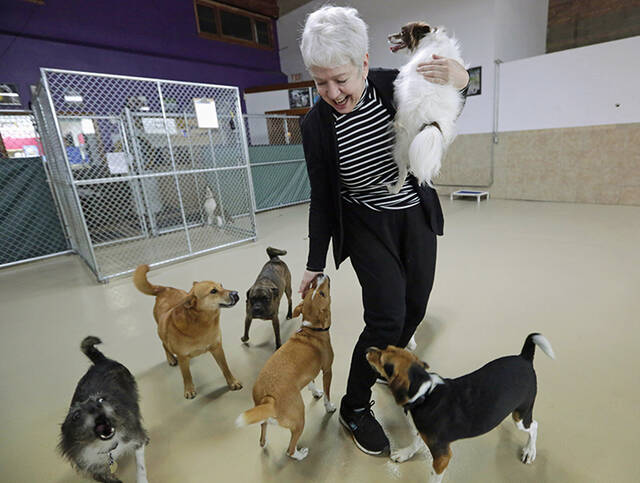Canine influenza: How to avoid spreading it, and symptoms to watch for
As the Speranza Animal Rescue in Mechanicsburg copes with an infection that rapidly spread among all 50 of their dogs, animal care professionals across the region are warning pet owners about recent canine influenza outbreaks.
“We’ve been seeing an increase [in cases], and sometimes they’re not definitively diagnosed,” said Erin Wicks, hospital administrator of Shores Veterinary Emergency Center in Harrisburg. “And with it being highly contagious, all it takes is one cross-contamination to infect your entire household if you have multiple dogs. It’s very hard to keep contained.”
Wicks said the University of Pennsylvania School of Veterinary Medicine put out alerts in February about the rapidly-spreading disease, and Shores put out its own earlier this month.
Dr. Stephen Cole, a veterinary clinical biologist at the University of Pennsylvania School of Veterinary Medicine, said H3N1, the current prevalent strain of the virus, first appeared in the United States in 2015. Since then, he said, “there have been reports of it throughout the country.”
“Throughout last summer and into the fall, there were lots of reports in the South,” Cole said. “They made their way up last December into Washington, D.C., where there were a lot of reports. And then we started seeing cases in January here in Philadelphia.”
Infection rates are hard to determine, particularly as many animals may be infected without being tested, and some carry the virus without any symptoms.
“What I can tell you is that in the seven years I’ve been working here, I had never seen a single case,” Cole said. “And now we’ve had about a dozen confirmed cases through the hospital.”
The disease spreads through three major pathways, Wicks said: direct animal-to-animal contact, through air with droplets from infected animals, and contact with infected materials, such as clothing or the skin of humans who interacted with infected animals.
Despite Speranza apparently doing everything properly, Wicks said, an infected animal may have slipped through their quarantine.
“If you’re dealing with an infected animal somewhere or you know there’s an infected animal somewhere, I would highly suggest changing clothes, putting them directly into the wash, taking a shower, things like that,” Wicks said. “If you were dealing with a dog hands-on that was infected, you can very easily take that home.”
A vaccine is available for pets, though availability may depend on individual veterinary offices. Wicks advised that some have the vaccine on back-order due to high demand, even before these outbreaks came to our area. Also, she said, the vaccine requires a booster shot, and so will not provide immediate immunity to animals, either.
“The vaccines are great, it’s the first step preventative measures to contracting it.” Wicks said. “It’s not [always] going to keep you from getting the flu, but it might make your symptoms a little bit better, a little bit easier to deal with. So vaccination is obviously the key, as well as keeping your pets, especially during an outbreak, away from places where there’s a lot of animals that you don’t know like dog parks, boarding facilities, things like that.”
Symptoms of canine influenza include lethargy, cough, lack of interest in food, fever, and runny eyes and noses. Dog owners who think their animal may be sick should call their veterinarian — and particularly, Cole said, make sure they check in before bringing the dog into the office, where it could potentially spread the disease to other animals.
“Virtually every dog that’s not vaccinated that comes into contact with a dog with canine influenza will become infected by the virus,” he said. “I think it’s a combination of dog behavior, the infectiousness of the virus, and on top of that, it’s not normally circulating in the population. There’s not really a built-up immunity to it, like many dogs have [for other diseases].”
READ MORE: Dog flu is on the rise in Pa.: Here’s how you can protect your pets
Much like influenza in humans, canine influenza can vary in severity. Wicks said that there have been fatal cases of canine influenza at Shores in the past, though none have been fatal recently.
Much like humans, many dogs will recover from influenza. Those at high risk are those who are old, young, or have other underlying health conditions.
“For most dogs this will be a mild illness,” Cole said. “The most important thing you can do is protect other dogs, by making sure you’re not taking your sick dog to places with other dogs.”
As with any health issue, Cole said, people should consult with their veterinarian if they are worried. And if an animal does become sick, he said, do your best to monitor their symptoms.
“You don’t want to see them get too lethargic,” he said. “Make sure that you’re monitoring their breathing - that they don’t seem to be needing to take deeper breaths, or are breathing considerably faster than normal. Those are both signs that it can be something more severe. Most owners know their dogs really well, so [monitor] changes in appetite, and things like that.”
Remove the ads from your TribLIVE reading experience but still support the journalists who create the content with TribLIVE Ad-Free.


